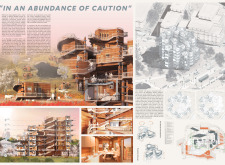5 key facts about this project
"In an Abundance of Caution" is a design that responds to the pressing demand for affordable housing in Melbourne. It tackles the challenges posed by a growing population and the complexities of climate change. The aim is to create living spaces that prioritize flexibility and community, enabling people to adapt to changing circumstances and environments.
Design Concept
The design centers around a flexible housing typology that shifts between dense urban living and self-sufficient micro-dwellings. This versatility allows for permanent yet adjustable living environments tailored to the needs of those who may face displacement from their homes. By breaking down the main structure into individual units, the design mitigates the risks of property loss and helps protect residents during extreme weather events.
Spatial Configuration
An important feature of the design is its modular layout, which enables efficient use of space. The units can tessellate and stack, combining essential functions like plumbing and electrical systems into a unified structure. This arrangement not only maximizes available space but also enhances community interaction by turning private terraces into shared areas. This design choice reduces the reliance on separate communal facilities, promoting a sense of togetherness among residents.
Material Selection
The project uses locally sourced insulated rammed earth, glued laminated timber, and repurposed modular metal grates. These materials were selected for their sustainability and affordability. Each contributes to the overall aim of creating accessible housing options without compromising quality. This focus on material choice aligns with environmental objectives, reinforcing responsible building practices that consider both people and the planet.
Adaptability and Site Potential
Flexibility in siting and density is evident in the hexagon-shaped tessellation and triangular glulam superstructure. These elements allow the units to cluster even on irregular sites that would typically be seen as unsuitable for housing. By embracing this approach, the design is able to adapt to urban growth and environmental shifts, remaining relevant and suitable in various contexts.
The integration of these elements leads to a design that meets the evolving needs of urban residents. It emphasizes both mobility and community, fostering engagement while addressing potential challenges from climate change. The outcome is a living environment that encourages both individuality and collaboration, redefining housing solutions for modern urban life.



















































